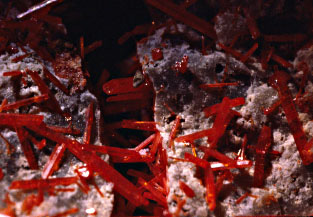Congratulations to the following 2007 Evolving Earth Student Grant recipients:
Benson, Mary Ellen
University of Colorado
“Exceptional diversity in late Eocene freshwater diatoms from the Florissant Formation, Teller County, Colorado”
While freshwater diatoms are described from as early as late Cretaceous, the diatoms from lake deposits of the late Eocene Florissant Formation are the most diverse early diatoms known in the fossil record. The presence of diatoms in close association with well-preserved leaf and insect fossils at this deposit has prompted some researchers to suggest that the diatoms, themselves, create conditions for exceptional preservation of the macrofossils. This study will document and characterize the flora, its relative abundance, diversity, and taxonomic composition within the context of the depositional system, the associated fossils, and the post-depositional processes. Although many genera observed here are known in modern environments, it is likely that some new species will be named. The presence of modern taxa in the Paleogene will result in a notable expansion of their geologic ranges. Diatom response to habitat change may inform us about lake history.
Childers, William
UCLA
“Drainage and morphological development of the Santa Monica Mountains and its implications for paleoseismicity in the greater Los Angeles area”
I propose to ascertain the long-term deformation rates across the Santa Monica Mountains (SMM) transpressional system. To achieve this goal, I will undertake a detailed geomorphologic investigation and dating of Quaternary surfaces, consisting in: mapping uplifted marine terraces; dating these terraces using the carbon-14 method; analyzing the process of drainage-divide retreat; carrying out detailed structural analysis across the SMM anticlinorium hinge to determine the direction and rate of its migration; and calculating the total slip on the underlying thrust based on the distance between these drainage and structural divides.
Crawford, Tafline
Washington University, St. Louis
“Comparative Analysis of Pliocene Australopithecines from Makapansgat, South Africa”
Makapansgat is both the earliest and the most northern of all South African Pliocene australopithecine sites. The sample is critical for examining australopithecine variation and a possible migration from East Africa. Examining australopithecine adaptions in the rich paleoecological context of Makapansgat will aid reconstructions of the ecological breadth of early fossil humans. My primary objectives are to present a detailed description of the Makapansgat australopithecines and to compare and contrast the entire sample to other australopithecine assemblages in South Africa. My result will aid: (1) discussions of regional morphological variation in South Africa australopithecines, (2) reassessments of the taxonomic and phylogenetic status of A. africanus, (3) resolution of whether Makapansgat and Sterkfontein sample different species or temporally and geographically distinct populations of A. africanus, and (4) discussion of the paleoecological context of early human evolution.
Flaig, Peter
University of Alaska – Fairbanks
“Sedimentology, Stratigraphy, and Paleoenvironment of the Upper Cretaceous Prince Creek Formation, North Slope of the Brooks Range, Alaska”
This project is part of a collaborative study incorporating both sedimentology/stratigraphy and paleontology to elucidate the paleoenvironment in north-central Alaska during a greenhouse phase of the Late Cretaceous at the end of the reign of the dinosaurs. Our goal is to reconstruct an ancient, high latitude dinosaur ecosystem. My portion of the project, which will partially fulfill the requirements for my Ph.D., involves a detailed sedimentological study of the Upper Cretaceous Prince Creek Formation including. (1) a comprehensive facies analysis to produce stratigraphic columns, (2) photography of laterally extensive outcrops for panoramic suturing and comparison/correlation with measured sections to reveal regional trends in facies deposition, and (3) collection of 400 – 500 samples for thin-sectioning, TOC, K-Ar dating, microprobe analysis, and clay mineralogy to establish paleosol types, provenance, palaeohydrology, age, regional unconformities, and paleoenvironmental conditions.
Gulley, Jason
University of Florida
“Direct Investigation of Englacial Conduits: A Plastic Karst Aquifer Approach to Glacier Hydrology”
Recent studies suggest that elevated melt rates accelerate ice sheet velocities in Greenland (Zwally et al, 2002). Accelerated flow of ice increases delivery of the ice to low elevation ablation areas and calving margins and understanding the processes responsible for the speedup of inland ice is important for determining the rate of sea level change and reduction in Earth’s albedo. Surface-derived meltwater penetrating to the glacier bed as been reported to “lubricate” glacier motion by elevating basal water pressures, but many fundamental issues remain poorly known, such as how englacial drainage systems develop in cold ice. According to classical glaciohydrologic theory, englacial conduits are thought to be arborescent and dip down glacier following the steepest hydraulic gradient along flow paths through intergranular porosity analgous to Darcian flow in a porous medium – however most observations of englacial conduits are at variance with theory. An alternative hypothesis for englacial conduit development based on the principles of limestone karst hydrology and adapted to glacier systems is proposed.
Knell, Michael
Montana State University
“Taphonomic variation in the Early Jurassic Lufeng Formation of ChuXiong Prefecture, Yunnan Province, People’s Republic of China”
The taphonomy of the Early Jurassic Lufeng Formation in ChuXiong Prefecture, Yunnan Province, China has never been studied. These rocks contain abundant vertebrate fossils including prosauropod dinosaurs. The goals of this project are to study the taphonomy of the ChuXiong vertebrates as well as the stratigraphy and sedimentology of the Lufeng Formation at a few selected localities across the prefecture and to find clues to help reconstruct the Early Jurassic paleoenvironment.
Lovelock, Elizabeth
University of California, Santa Barbara
“A Paleobotanical Climate Analysis of the Early Paleogene of Northern California”
I intend to use two fossil floras, Moonlight (ML) and Susanville (SV), from the Diamond Mountains, northern Sierra Nevada, to establish the terrestrial climate of northern California during the early Paleogene. The age of these floras is poorly constrained. Field work studying the stratigraphy and mapping the area in detail will provide more information about their geologic context. If ML and SV are early Eocene as hypothesized, they are the only known leaf fossil localities from the central Pacific coast of North America from that time period. Using the Leaf Margin Analysis (LMA) I intend to test the difference in the paleoclimate of the west coast as compared to the interior of North America during the early Paleogene.
McFadden, Kathleen
Virginia Tech
“Integrating high-resolution paleoenvironmental proxies to analyze the Ediacaran Doushantuo Formation, South China: Implications for the rise of oxygen and biological evolution”
Several recent hypotheses argue that oxygenation during the Ediacaran Period (635-542 Ma) either occurred in stages or as a single protracted event. However, these studies were based on geological successions with a limited fossil record, restricting our understanding of the interaction between environment and biological evolution. The Doushantuo Formation, South China has the potential to clarify the global picture of Ediacaran biological and geochemical events because it contains both the geochemical proxies and a thriving fossil record required to test these hypotheses. This study aims to integrate high-resolution (cm-dm scale) paleoenvironmental proxies of the Doushantuo Formation, Yangtze Gorges, South China to investigate local and global geochemical signals related to redox conditions, climatic change, and combined microfossil data to understand the relationship between the rise of oxygen and evolutionary events during the Ediacaran Period.
Reverman, Rebecca
University of Cincinnati
“From Mid-Crustal Depths to Soaring Peaks: The Tectonic, Temporal and Thermal Evolution of the Indus Suture Zone, eastern Ladakh, NW Himalaya”
I will determine the Pressure – Temperature – Time – deformation path for the Lamayuru formation (Tethyan Basin) of the Indus Suture Zone (ISZ) in eastern Ladakh. This path will constrain the mechanisms for uplift and exhumation and I will be able to draw conclusions about whether tectonic processes or surface processes control mountain landscape evolution. I will also integrate the history of the Lamayuru into previously and vastly different determined histories of the Indian and Asian continental margins to create a thorough tectonic, temporal and thermal evolution for the ISZ.
Shaw, Barbara
Portland State University
“Enigmatic anteaters, sloths, and armadillos (Superorder Xenarthra): elucidating evolutionary relationships among xenarthran families and remaining mammals”
A comprehensive morphological analysis of the Superorder Xenarthra has never been undertaken. This information can yield information about their phylogenetic history and elucidate the dispersion from South America into North America during the Great American Biotic Exchange. So far, I have examined 56 species (31 fossil and 45 extant species) from 411 US museum specimens. North American fossils date back only 9 million years, even though this taxon is hypothesized to have originated in the late Cretaceous. To include the oldest material available, I need to go to Argentina to examine the fossils housed in the museums there. Without these specimens, the morphological analysis is only comprehensive for North America and not the entire taxon.

